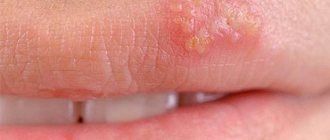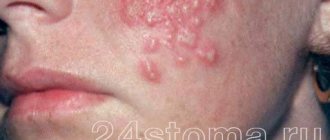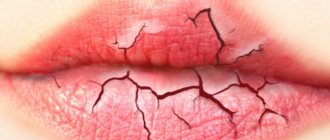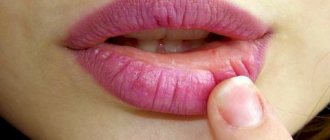Many people are familiar with such an expression as cold sore lips. It is usually used when a bubble with transparent contents forms in the lip area, which subsequently bursts and the affected area becomes covered with a crust. Cold sores are an infectious disease caused by the herpes simplex virus type 1 or 2. The source of infection can be infected people, both with and without pronounced signs of herpes. Cold on the lips is not limited to the presence of the virus only in this area. In patients herpes virus detected in body fluids such as blood (including menstrual fluid), urine, nasal discharge and tear ducts, vaginal secretions, amniotic fluid and semen. How the virus is transmitted and how to treat herpes is discussed in this article.
How does herpes infection occur?
As mentioned above, colds on the lips are caused by two types of viruses - herpes virus type 1 and herpes virus type 2 . Infection with herpes virus type 1 mainly occurs in childhood and adolescence. The main routes of transmission of infection are contact (for example, through personal objects) and airborne droplets (by inhaling the virus, kissing). However, infection can also occur through oral-genital contact. Infection with herpes virus type 2 occurs through direct sexual contact and is therefore more common among young people and adults. Transmission of pathogens of both types 1 and 2 can occur from mother to fetus (transplacentally), and also in isolated cases through infected blood products (parenterally). It is worth noting that the risk of infection increases significantly if an infected person has herpetic rashes on the skin and mucous membranes.
Herpes on the lips. Diagnostics
If typical symptoms are present, the diagnosis is made based on clinical data; laboratory confirmation is not required.
Laboratory confirmation is required in the following cases:
- when establishing the etiology of the disease in asymptomatic and chronic relapsing course,
- when establishing the etiology of the disease during dissemination of the process,
- when uncharacteristic rashes or atypical localization of rashes appear,
- when establishing the etiology of the infectious process in HIV-infected persons or persons with secondary immunodeficiencies of various origins.
In the above cases, the diagnosis must be established based on a combination of anamnestic, epidemiological, clinical data and laboratory research methods. The specificity of the patient’s rash is confirmed by laboratory methods: either by isolating the virus in cell culture (“gold standard” of diagnosis); or by identifying virus antigens; or by determining viral DNA in discharge from the lesion, in biological materials from the patient using polymerase chain reaction (PCR). To do this, material is taken directly from areas of rashes suspected of herpes. The state of humoral immunity in a patient is assessed by identifying specific antibodies of the IgG and IgM classes to HSV-2/-1 in the blood serum (for this diagnosis it is necessary to donate blood from a vein) using the enzyme-linked immunosorbent assay (ELISA). Detection of IgM and IgG antibodies to HSV determines the duration and severity of the disease and answers the question: is a person infected with HSV?
If you have herpes on your lips, what should you do?
Consult a doctor (infectious disease specialist, dermatologist-venereologist) for advice.
Self-medication is not acceptable!
If your herpes on the lips does not go away, often recurs, and is accompanied by complications, what should you do?
It is recommended to consult a doctor for advice; confirm the specificity of rashes on the lips using laboratory methods, examine the intensity of antiherpetic immunity, the state of the immune status, and sensitivity to antiviral drugs.
Discuss on the forum
Forms of herpetic infection
There are several forms of herpes infection. The bullous form of herpes is characterized by the appearance of blisters that can reach the size of a plum. The abortive form occurs without the formation of a blistering rash, and at the site of the lesion there is swelling and small cone-shaped elevations above the surface of the skin or mucous membranes. The most severe forms of herpes are ulcerative, ulcerative-necrotic and gangrenous. They are characterized by the appearance of vesicles with hemorrhagic contents, the appearance of long-term non-healing deep ulcers that leave scars. The development of the gangrenous form occurs in people weakened by any diseases, as well as in elderly patients with gastric ulcers, diabetes mellitus and other concomitant pathologies.
Additional measures
Some categories of patients are particularly sensitive to certain drugs. For some they are completely contraindicated. Additional measures must be taken to treat such patients. So, in the first trimester of pregnancy, taking medications is generally undesirable. It is better to use folk remedies. In the last three months you should not drink a lot of liquid. Although this helps to cope with ARVI, the consequences can be serious. Sodium leaching and kidney overload are very dangerous for a pregnant woman.
When treating children under three years of age, essential oils are contraindicated. If they help an adult to recover, in a child, the course of the disease, on the contrary, may become more severe. In addition, the risk of an allergic reaction from an incompletely formed immune system cannot be ruled out.
Provocateurs of herpes infection
Colds on the lips rarely have an acute form; a chronic course of the disease is much more common. According to WHO, approximately 70% of people around the world are infected with the herpes simplex virus and about 10-20% of patients experience various symptoms of herpes infection. Exacerbations of chronic herpes occur for a number of reasons. The main factors that lead to relapse are emotional and physical stress, hypothermia, sexual intercourse, menstruation in women, concomitant diseases (ARVI, including influenza), ultraviolet radiation and others.
Cure a cold in one day
Medicines that are freely sold in all pharmacies will help us with this. Our goal is to quickly eliminate symptoms.
| Symptom | What do you need | Examples of active ingredients |
| General weakness and fever | Antipyretic, anti-inflammatory, analgesic | Ibuprofen Paracetamol |
| A sore throat | Antiseptics | Hexethidine Biclotymol Ambazon |
| Runny nose | Antiseptics, decongestants, vasoconstrictors | Xylometazoline Sea water Phenylephrine |
| Cough | Secretolytics, mucolytics | Ambroxol Bromhexine Thermopsis herb Ginger rhizome extract Acetylcysteine |
Why is the herpes virus dangerous?
The herpes simplex virus affects many organs and systems. Herpetic blisters can appear on the mucous membranes of the vagina, cervix, urethra, mouth and skin, and with an extensive process they can appear in the liver and brain. Herpes can cause dysfunction of both the autonomic and central nervous systems. In addition, the herpes virus is associated with cancer, unfavorable pregnancy, childbirth, as well as pathologies in the fetus and newborns. According to the World Health Organization, the mortality rate from severe forms of the herpes simplex virus is 15.8% compared to other viral infections and ranks second after deaths from influenza (35.8%). In our country, the number of patients diagnosed with herpes infection every year exceeds 2.5 million. Patients with chronic herpetic lesions of the skin and genitals make up more than 10% of the total population of Russia.
Cold symptoms
The first signs of the disease may appear a couple of hours after infection, or may not be felt for up to two days. Symptoms usually occur in this order:
- Day 1. Sore throat caused by pharyngitis - inflammation of the pharyngeal mucosa.
- Day 2-3. Runny nose, sneezing, feeling of stuffiness caused by rhinitis - inflammation of the nasal mucosa.
- Day 4-5. A cough that occurs due to a sore throat that irritates the cough receptors. As the virus moves towards the bronchi, coughing becomes a reaction to increased secretion and is necessary to remove sputum.
Weakness and body aches may accompany the patient all the time, or may go away on the third day. These are common manifestations of asthenic syndrome. It may also include photophobia, emotional depression, and heightened sensitivity to sounds and smells. All this indicates an increased load to which the nervous system is exposed during illness.
Treatment of herpes
The herpes virus enters the body through the mucous membranes and settles in the nerve ganglia for life. Therefore, it is impossible to completely get rid of the pathogen. However, with proper therapy, it is possible to reduce the intensity of the rash, significantly reduce the duration of the prodromal period and reduce the frequency of exacerbations. Treatment of herpes at home includes antiviral therapy using antiherpetic drugs. But since colds on the lips are accompanied by immunodeficiency, the treatment regimen also includes immunomodulatory agents, for example, interferon preparations or its inducers. In the combined treatment of herpes, the drug Viferon can be used, which resists viruses and corrects protective functions. Using the drug in a treatment regimen allows you to quickly relieve the symptoms of herpes and prolong remission. In addition, the good tolerability of the drug makes it possible to use it in children and pregnant women.
Based on materials:
1. Malinovskaya V.V., Delenyan N.V. et al. "Viferon". Guide for doctors. M. 2004. 6. Malinovskaya V.V., Uchaikin “Viferon (suppositories and gel) in the complex therapy of herpes virus infections”, A.A. Haldin, D.V. Baskakova, A.N. Vasiliev. 2. “Algorithm for the treatment of exacerbations and secondary prevention of herpes simplex with Viferon”, A. A. Khaldin, I. V. Polesko. 3. “Algorithm for the treatment of exacerbations and secondary prevention of herpes simplex with Viferon”, Haldin A.A., Polesko I.V.
Loading...
Take other surveys
How to distinguish a cold from other diseases?
A cold is an unpleasant phenomenon, but relatively safe. However, other, more serious diseases can manifest exactly the same symptoms. Therefore you need to know the following:
- Fever does not always occur with a cold. It never exceeds 39 degrees and subsides after a maximum of two days. Otherwise, we are no longer talking about ARVI, but about the flu.
- A sore throat does not always indicate a cold. If it does not go away for a long time, it is accompanied by enlarged lymph nodes and the appearance of purulent plaque on the tonsils, this indicates tonsillitis (tonsillitis). Antibacterial therapy is already required here.
- A cough with acute respiratory infections lasts no longer than two weeks. If it continues, it is possible that pneumocystis, fungi or mycoplasma have entered the body.
So you shouldn’t attribute any ailment to a cold. Otherwise, there is a high risk of not paying attention to the emerging dangerous disease. It will be more difficult to treat in the future.
How to properly store Allomedin® gel, are there any special conditions?
Allomedin® should be stored in a dry place, protected from sunlight, out of reach of children, at a temperature of +2 to +8ºС (normal refrigerator mode). However, for ease of use and transportation, storage without refrigeration (at temperatures from +2 to +25ºС) for 1 month is permissible.
Sources
- V. A. Isakov, S. B. Rybalkin, M. G. Romantsov. Herpesvirus infection: Recommendations for doctors - St. Petersburg, 2006. - 96 p.
- S. Chernysh, I. Kozuharova. Anti-tumor activity of a peptide combining patterns of insect alloferons and mammalian immunoglobulins in naïve and tumor antigen vaccinated mice. International Immunopharmacology, 2013, v. 17, pp. 1090–1093.
Causes of the disease
Herpes is an infectious disease. This is a virus that enters the body in different ways:
- sexual;
- contact (household);
- airborne (sneezing, coughing);
- placental (from a pregnant woman to a child).
In this case, herpes is most often transmitted by contact. The virus lives in saliva, so a person can become infected through a kiss, toys, underwear, dishes and other objects.
There are several factors that provoke the activation of the virus:
- constant stress;
- depressive states;
- prolonged hypothermia of the body, including one-time hypothermia;
- ARVI with and without complications;
- diseases that suppress the human immune system;
- bad habits, especially alcoholism, unhealthy diet;
- severe intoxication;
- Alzheimer's disease.
Herpes is present in the body of almost every person, but most of the time it is in an inactive state. Usually the virus “wakes up” against a background of weakened immunity. This can happen for various reasons, including against the background of severe stress, lack of sleep and other unfavorable factors.
Myths about colds
Although acute respiratory infection has been known to medicine for a long time, there are still myths about its treatment methods and precautions. We have collected the most popular of them:
| Myth | In fact |
| If you have a cold, you should keep the windows closed and not go outside. | Fresh air is the enemy of the virus. Regular ventilation keeps the house free from infections. |
| The patient needs to be warmed. | No one has canceled the body’s need for normal thermoregulation. Overheating is no less dangerous than hypothermia. |
| A person with a cold should not wash. | In cold water it’s really not worth it, because hypothermia weakens the immune system. It’s possible and even necessary in a warm place. The patient sweats, and with then toxins come out. They need to be washed off. |
| Ice cream is a surefire way to catch a cold. | The cause of the disease is a virus, not a cold. Whether a person will eat so much ice cream to weaken their immune system is a big question. When you have a sore throat, this dessert is actually useful. It relieves swelling, inhibits the inflammatory process and reduces discomfort. |
We are going on vacation to hot countries. What to add to a standard traveler's first aid kit?
A sharp change in climate and excess UV radiation lead to overheating of unprepared areas of the skin, which disrupts the functioning of the skin’s immune cells and reduces the ability to identify and “defeat uninvited guests.”
To reduce the harmful effects of high temperatures on the skin, include Allomedin® gel in your usual beach post-care routine. The gel should be applied after a shower to areas of the skin exposed to intense (excessive) insolation. It is not difficult to identify them: these are always open areas of the body (for example, the face), and in addition, such skin continues to “burn” even several hours after exposure to the sun. Allomedin® gel will quickly soothe, cool the skin and restore the functioning of “protective cells”.










